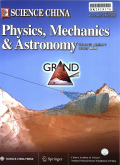- 钛学术文献服务平台 \
- 学术期刊 \
- 基础科学期刊 \
- 自然科学总论期刊 \
- 中国科学:物理学 力学 天文学(英文版)期刊 \
null
Energetics and structures of hydrogen-vacancy clusters in tungsten based on genetic algorithm
基本信息来源于合作网站,原文需代理用户跳转至来源网站获取
摘要:
The behavior of hydrogen (H) in metals has been a longstanding research topic in materials science.One of the most compelling subjects is the deleterious effects of H on the microstrumctural evolution of materials;these effects include H embrittlement,superabundant vacancy formation,and blistering.Vacancies have been demonstrated through both experiments and computational simulations to have strong H trapping effects [1],resulting in increased H retention [2],gas-filled bubble formation [3-5],and surface modification [6-9].In addition,at high temperatures and high H pressures,superabundant vacancy formation induced by H is observed [10,11].Unfortunately,even though substantial research has been conducted on the interplay between H and vacancies [12-14],the detailed processes by which H-vacancy complexes nucleate,grow,and agglomerate remain unclear.In these processes,the energetics and structures of H-vacancy clusters are undoubtedly important.They may not only quantify the interaction between H and vacancies but also provide information about the mechanism by which H-vacancy complexes grow.

推荐文章
期刊_丙丁烷TDLAS测量系统的吸收峰自动检测
带间级联激光器
调谐半导体激光吸收光谱
雾剂检漏 中红外吸收峰 洛伦兹光谱线型
不同盐度、温度及光照对漂浮浒苔生理生态的影响
浒苔
盐度
温度
光照
生理生态
期刊_联合空间信息的改进低秩稀疏矩阵分解的高光谱异常目标检测
高光谱图像
异常目标检测 低秩稀疏矩阵分解 稀疏矩阵 残差矩阵
内容分析
关键词云
关键词热度
相关文献总数
(/次)
(/年)
文献信息
| 篇名 | Energetics and structures of hydrogen-vacancy clusters in tungsten based on genetic algorithm | ||
| 来源期刊 | 中国科学:物理学 力学 天文学(英文版) | 学科 | |
| 关键词 | |||
| 年,卷(期) | 2018,(10) | 所属期刊栏目 | |
| 研究方向 | 页码范围 | 100-103 | |
| 页数 | 4页 | 分类号 | |
| 字数 | 语种 | 英文 | |
| DOI | |||
五维指标
引文网络
引文网络
二级参考文献 (0)
共引文献 (0)
参考文献 (0)
节点文献
引证文献 (0)
同被引文献 (0)
二级引证文献 (0)
2018(0)
- 参考文献(0)
- 二级参考文献(0)
- 引证文献(0)
- 二级引证文献(0)
引文网络交叉学科
相关学者/机构
期刊影响力
中国科学:物理学 力学 天文学(英文版)
主办单位:
中国科学院
出版周期:
月刊
ISSN:
1674-7348
CN:
11-5849/N
开本:
16开
出版地:
北京东黄城根北街16号
邮发代号:
80-212
创刊时间:
2004
语种:
eng
出版文献量(篇)
3714
总下载数(次)
0
总被引数(次)
10002
期刊文献
相关文献
推荐文献
- 期刊分类
- 期刊(年)
- 期刊(期)
- 期刊推荐
力学
化学
地球物理学
地质学
基础科学综合
大学学报
天文学
天文学、地球科学
数学
气象学
海洋学
物理学
生物学
生物科学
自然地理学和测绘学
自然科学总论
自然科学理论与方法
资源科学
非线性科学与系统科学
中国科学:物理学 力学 天文学(英文版)2022
中国科学:物理学 力学 天文学(英文版)2021
中国科学:物理学 力学 天文学(英文版)2020
中国科学:物理学 力学 天文学(英文版)2019
中国科学:物理学 力学 天文学(英文版)2018
中国科学:物理学 力学 天文学(英文版)2017
中国科学:物理学 力学 天文学(英文版)2016
中国科学:物理学 力学 天文学(英文版)2015
中国科学:物理学 力学 天文学(英文版)2014
中国科学:物理学 力学 天文学(英文版)2013
中国科学:物理学 力学 天文学(英文版)2012
中国科学:物理学 力学 天文学(英文版)2011
中国科学:物理学 力学 天文学(英文版)2010
中国科学:物理学 力学 天文学(英文版)2009
中国科学:物理学 力学 天文学(英文版)2008
中国科学:物理学 力学 天文学(英文版)2007
中国科学:物理学 力学 天文学(英文版)2006
中国科学:物理学 力学 天文学(英文版)2005
中国科学:物理学 力学 天文学(英文版)2004
中国科学:物理学 力学 天文学(英文版)2003
中国科学:物理学 力学 天文学(英文版)2018年第9期
中国科学:物理学 力学 天文学(英文版)2018年第8期
中国科学:物理学 力学 天文学(英文版)2018年第7期
中国科学:物理学 力学 天文学(英文版)2018年第6期
中国科学:物理学 力学 天文学(英文版)2018年第5期
中国科学:物理学 力学 天文学(英文版)2018年第4期
中国科学:物理学 力学 天文学(英文版)2018年第3期
中国科学:物理学 力学 天文学(英文版)2018年第2期
中国科学:物理学 力学 天文学(英文版)2018年第12期
中国科学:物理学 力学 天文学(英文版)2018年第11期
中国科学:物理学 力学 天文学(英文版)2018年第10期
中国科学:物理学 力学 天文学(英文版)2018年第1期

 免费查重
免费查重










